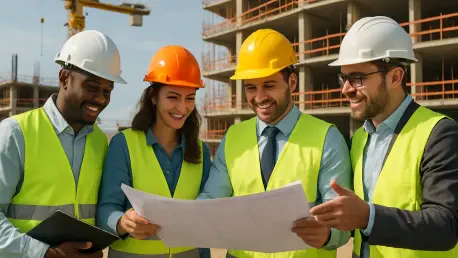In the dynamic world of construction management, few bring as much insight to the table as Luca Calarailli. With a robust background in design and architecture, Luca has spent decades shaping the industry, championing innovative tools and technology to push boundaries. His expertise in public contracting and dispute resolution, particularly with progressive design-build methods, makes him a sought-after voice on minimizing conflicts in major projects. Today, Joshua Fairbourne sits down with Luca to explore the power of communication, the advantages of progressive delivery approaches, the challenges of megaprojects, and the resilience of state and local construction amidst economic hurdles.
Can you walk us through the concept of ‘talk early, talk often, talk honestly’ in the context of public construction projects, and why it’s so essential?
Absolutely, Joshua. This mantra is all about building trust and transparency from the get-go. Talking early means engaging all stakeholders—owners, contractors, designers—right at the project’s inception, even before contracts are signed. Talking often ensures everyone stays on the same page through regular check-ins, whether it’s weekly meetings or quick updates. And talking honestly? That’s the tough part. It means not shying away from bad news, like delays or cost overruns. Honesty prevents small issues from festering into major disputes. I’ve seen projects derail because someone held back critical info, hoping it would resolve itself. It rarely does.
How does the progressive design-build delivery method differ from traditional approaches, and what makes it so effective in reducing disputes?
Progressive design-build stands out because it integrates design and construction teams from the very start, unlike traditional methods where these phases are often siloed. This approach lets you phase the project, so construction can begin while design is still being finalized, saving time. More importantly, it fosters collaboration by having everyone at the table early, sharing risks and ideas. I’ve worked on projects where this method cut dispute risks dramatically because misunderstandings were caught before they escalated. It’s not just about speed; it’s about delivering a better end product with fewer headaches.
Can you share a specific example from your experience where progressive design-build made a tangible difference in a project’s outcome?
Sure, I was involved in a mid-sized public infrastructure project a few years back—a new transit hub. We adopted progressive design-build, which allowed us to start foundational work while finalizing upper-level designs. When we hit a snag with unexpected site conditions, the early collaboration between the contractor and design team meant we could pivot quickly, adjusting plans without halting progress. Without that integrated approach, we’d have faced months of delays and likely ended up in a dispute over who was at fault. Instead, we finished close to schedule and kept everyone aligned.
Why do communication breakdowns have such a profound impact on construction projects, and what early signs should teams watch for?
Communication breakdowns are often the root of most project issues because they create misalignment. When teams aren’t talking, assumptions creep in, and small errors—like a missed design detail—can snowball into costly delays or scope changes. Early signs include inconsistent updates, stakeholders skipping meetings, or vague responses to critical questions. I’ve noticed that when people start avoiding tough conversations, that’s a red flag. Catching these early by encouraging open dialogue can prevent a minor hiccup from becoming a full-blown conflict.
With an estimated $500 billion in U.S. megaprojects on the horizon, what unique challenges do you see in managing disputes on such a massive scale?
Megaprojects come with amplified risks due to their complexity and sheer size. You’ve got multiple stakeholders, sprawling supply chains, and often tight timelines. Disputes over design changes, late information, or cost overruns can delay a project by over a year, which is devastating at this scale. Inflation and supply chain disruptions only heighten the tension, as costs spike unpredictably, leading to disagreements over who absorbs the hit. Managing these requires robust communication frameworks and risk-sharing models upfront, ideally at a policy level, to set clear expectations across state or national initiatives.
Despite economic challenges, state and local governments continue to push forward with construction projects. What do you think is driving this momentum?
I think it’s largely about immediate needs and community pressure. State and local governments are closer to the ground—they see crumbling infrastructure, growing populations, and urgent demands for schools or transit. They can’t afford to wait out economic uncertainty. Plus, many have secured funding through bonds or local taxes that need to be spent. This contrasts with federal projects, like those under the Department of Transportation, which often face bureaucratic delays or funding holds due to broader economic policies. It’s a bold move, but it shows prioritization of public good over hesitation.
What are some of the most common causes of delays and disputes in major public projects, and how can they be mitigated?
The big culprits are design issues, scope creep, and late information sharing. A flawed design can halt construction, while a change in scope mid-project throws budgets and timelines into chaos. Late info—like delayed permits or site data—just compounds the problem. Mitigation starts with early involvement of all parties to iron out design kinks before breaking ground. Clear contracts that outline scope change processes help, too. And honestly, investing in tech tools for real-time data sharing can cut down on those late surprises. It’s about proactive planning rather than reactive firefighting.
What is your forecast for the future of dispute resolution in public construction as we tackle these large-scale projects?
I’m optimistic, Joshua. I see the industry moving toward even more collaborative models like progressive design-build, supported by technology. Tools for real-time communication and project tracking are becoming game-changers, reducing misunderstandings before they turn into disputes. I also expect alternative dispute resolution methods, like mediation, to gain traction over litigation, saving time and money. As megaprojects grow, I think we’ll see more standardized frameworks for risk-sharing and communication at the policy level. It’s all about building trust and efficiency into the process from day one.









